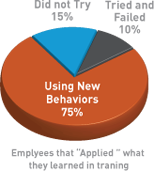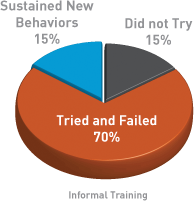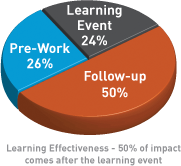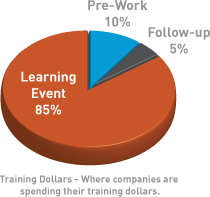
Not at Leadership Choice
Early research shows that nearly 75% of managers and leaders who participate in our programs using the PEP Model™ are actually demonstrating the new behaviors on the job and continue to do so!I valued the time spent with my coach to assist me in my job transition. He was professional, insightful, and pleasant to work with. He has provided the strategies and tools to be successful.
Research
Unfortunately, traditional approaches to training by itself does not lead to positive business outcomes. The following studies illustrate this point.- Rob Brinkerhoff (2008) described a study that queried a large number of employees who had recently gone through training about the application what they had learned. Only 15% reported that they sustained new behaviors, 70% said they had tried and failed, and 15% reported that they did not try the new skills.
 Brinkerhoff, Robert O. (2008). "Training Impact Evaluation That Senior Leaders Believe and Use: The Success Case Method." Workshop presented at Training 2008 Exposition and Conference, Atlanta, GA, February 4.
Brinkerhoff, Robert O. (2008). "Training Impact Evaluation That Senior Leaders Believe and Use: The Success Case Method." Workshop presented at Training 2008 Exposition and Conference, Atlanta, GA, February 4. - A University of Phoenix Study in 2004 showed that 26% of learning effectiveness occurs prior to a learning event, and a full 50% of learning effectiveness comes as a follow up to the learning event. The same study found that 85% of training dollars were spent on the training event itself. (Peterson 2004).

 Peterson, Brent. (2004). Unpublished paper from Apollo Consulting Group. University of Phoenix
Peterson, Brent. (2004). Unpublished paper from Apollo Consulting Group. University of Phoenix - An ASTD (2006) study identified the causes of training not leading to expected results. It found that 20% was caused by events and circumstances prior to training. An additional 10% was caused by sub-par delivery of the programs. A whopping 70% was due to problems with what they referred to as the "application environment". The latter consisted primarily of two factors: participants not having the opportunity to use what they learned, and non-reinforcing supervisors' actions following the training event.
- A Josh Bersin (2008) study showed a strong trend toward informal learning. Twenty percent of job-relevant learning was found to occur prior to formal training programs, 10% during training, and as much as 70% as on-the-job learning.
